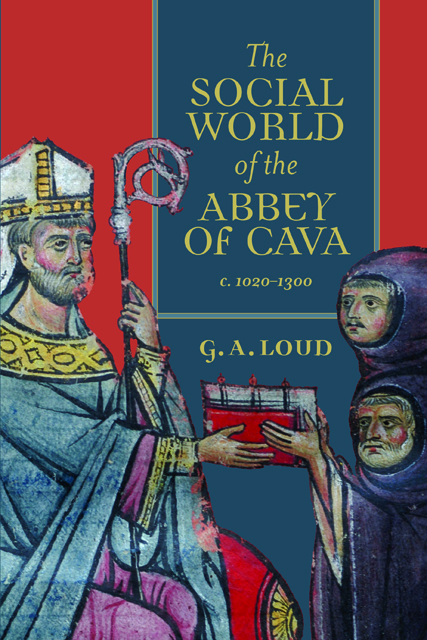Book contents
- Frontmatter
- Dedication
- Contents
- List of Maps and Charts
- Acknowledgements
- List of Abbreviations
- Note on the Organisation and Publication of the Cava Archive
- Dates
- Currency, Weights and Measures
- The Abbots of Cava, c. 1020-1300
- Maps
- I The Family of Vivus Vicecomes
- Introduction
- Part I The Abbey of Cava
- Part II Society and Economy
- Conclusions
- Appendix: Purchase and Expenditure by the Abbey of Cava, at Selected Periods between 1175 and 1230
- Bibliography
- Index
- Other volumes in Studies in the History of Medieval Religion
3 - Defending Monastic Lordship, c. 1190-1300
Published online by Cambridge University Press: 14 January 2023
- Frontmatter
- Dedication
- Contents
- List of Maps and Charts
- Acknowledgements
- List of Abbreviations
- Note on the Organisation and Publication of the Cava Archive
- Dates
- Currency, Weights and Measures
- The Abbots of Cava, c. 1020-1300
- Maps
- I The Family of Vivus Vicecomes
- Introduction
- Part I The Abbey of Cava
- Part II Society and Economy
- Conclusions
- Appendix: Purchase and Expenditure by the Abbey of Cava, at Selected Periods between 1175 and 1230
- Bibliography
- Index
- Other volumes in Studies in the History of Medieval Religion
Summary
When King William II of Sicily died on 18 November 1189 the abbey of Cava was at its zenith. Not only was its reputation at its height, both within the Church and with the ruler and secular powers of the kingdom, but so too were its material fortunes. It was a major land holder within the principality of Salerno, with concentrations of property not just in the immediate environs of the abbey and in and around the city of Salerno, but also on the northern border of the principality around Nocera and Montoro, in the plain to the south of Salerno and in Cilento. Its congregation of dependent churches and monasteries had also reached its peak, and had spread throughout Apulia, from the Gargano peninsula in the north to the Terra d’Otranto in the south, and into Lucania. There were, too, a few Cava dependencies in Calabria, and even three churches on the island of Sicily.
The death of the childless King William led, however, to a long period of dispute and disorder within the kingdom of Sicily, which was not finally ended until the restoration of royal authority by the Emperor Frederick II in the early 1220s. The abbey of Cava survived this period of uncertainty relatively unscathed, but not completely unaffected, and thereafter was essentially on the defensive, fending off the claims of royal officials, and sometimes too diocesan bishops who laid claim to its dependencies, and after 1250 facing a more uncertain economic future and increasing problems in retaining control of its more outlying possessions. To do so successfully required vigilance and persistence, and also led to increasing recourse to forgery to defend the abbey’s interests.
A Time of Uncertainty
The immediate consequence of King William’s demise, at the early age of thirty-six, was a disputed succession to the throne. The king had previously designated his aunt Constance, King Roger’s posthumous daughter (who was actually slightly younger than her nephew), as his heir, on her marriage to the heir to the German throne, the future Emperor Henry VI, in 1186. Whether the king ever intended her to succeed him is open to question – he may still have expected to have a child.
- Type
- Chapter
- Information
- The Social World of the Abbey of Cava, c. 1020-1300 , pp. 68 - 109Publisher: Boydell & BrewerPrint publication year: 2021



